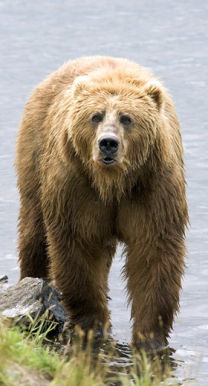 Bear (Ursidae) is a family of very large terrestrial predators. The name björn (singular) is the etymological meaning brown and is an old noaord in Swedish, as in other Germanic and Slavic languages. The original, taboo, the name of the animal is no longer known, according to Wikipedia.
Bear (Ursidae) is a family of very large terrestrial predators. The name björn (singular) is the etymological meaning brown and is an old noaord in Swedish, as in other Germanic and Slavic languages. The original, taboo, the name of the animal is no longer known, according to Wikipedia.
Photo of brown bear – Wikimedia Commons – Source: Wikipedia | Text translated with Google Translate thus grammatical errors.
Bear Anatomy
Bears survive well and for a long time exclusively by plants. This applies particularly to the younger bears. In the older bears predator behavior emerges stronger. Bears differs from the other family in the same order in that they generally have a large and bulky body, short tail and straight tear with long, blunt claws, which can not be withdrawn.
Grizzly Bear (grizzlybjörn), Kodiak bear, black bear, Mexican brown bear (extinct) and brown bears (brunbjörn) are examples of bears.
The eyes are small and the ears are round and upside. The hair is usually long and in most species, plain and usually brown or black. The exception is the giant panda with striking black and white drawing and polar bears are white. Lighter markings on the chest and the face is in some species.
They have an elongated nose. Bears are plantigrade and their soles are usually equipped with hair. Only a few species often climbing trees, such malajbjörnen, have naked soles of the feet. The tail is just a small stub.
The weight varies between 25 (Sun Bear) and about 800 kg (polar bear, up to 1 ton), the males are always considerably heavier than females. The length is between 100 and 280 cm.
Distribution
Bears live in Eurasia, and North and South America and was previously also in northern Africa. In Africa today met with no more bears. On the South American continent they occur only in the northwestern part. In western and central Europe today has residual stocks. Brown bear population that lived in the Atlas Mountains became extinct during the 1800s. Bears can adapt to very different climate zones and why they occur in both polar regions, in the rain forest and grasslands. The animal avoids the desert.
Diet
The species is mainly omnivorous with the exception of the giant panda who live mainly of bamboo shoots and the polar bear which has meat as staple food.
Bears are omnivores (omnivores), except for the giant panda feeding on bamboo. Fruits, berries and other plants make up a large part of their diet, especially during the fall. Bears eat large mammals such as deer and occasionally livestock. Bears like to eat insects, larvae and small vertebrates like fish and rodents. The sense of smell plays an important role in food to be found.
Ecology
Bears are generally solitary animals that are active during dusk and night (not polar). The rest often in caves in the mountains and forests, hollow logs and burrows. Their way to get around is mostly a slow pacing, but when needed they reach a speed up to 40 km / h. Bears can climb very well and they can even swim excellent.
Several species hibernate or falling into a rigid state during the colder months. It discusses the rest to be considered true hibernation, because the body temperature does not drop and they are easy to wake up from sleep. Heartbeat and breathing rate decreases, however, clearly during sleep. During late summer and autumn, they eat a lot for having a fat reserves for the winter.
Summary: Stig Björne